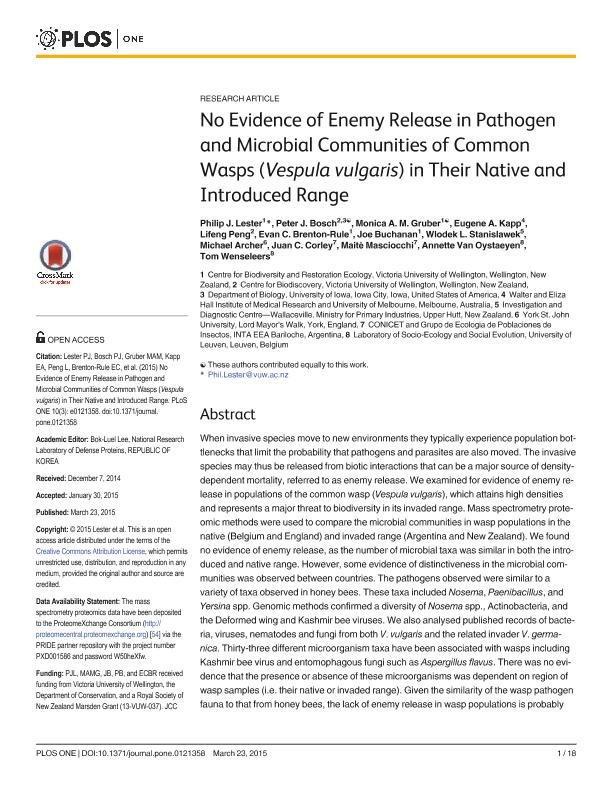Mostrar el registro sencillo del ítem
dc.contributor.author
Lester, Philip J.
dc.contributor.author
Bosch, Peter J.
dc.contributor.author
Gruber, Monica A.M.
dc.contributor.author
Kapp, Eugene A.
dc.contributor.author
Peng, Lifeng
dc.contributor.author
Brenton Rule, Evan C.
dc.contributor.author
Buchanan, Joe
dc.contributor.author
Stanislawek, Wlodek L.
dc.contributor.author
Archer, Michael
dc.contributor.author
Corley, Juan Carlos

dc.contributor.author
Masciocchi, Maité

dc.contributor.author
Van Oystaeyen, Annette
dc.contributor.author
Wenseleers, Tom
dc.date.available
2018-03-06T18:10:20Z
dc.date.issued
2015-03
dc.identifier.citation
Lester, Philip J.; Bosch, Peter J.; Gruber, Monica A.M.; Kapp, Eugene A.; Peng, Lifeng; et al.; No evidence of enemy release in pathogen and microbial communities of common wasps (vespula vulgaris) in their native and introduced range; Public Library of Science; Plos One; 10; 3; 3-2015; 1-18; e0121358
dc.identifier.uri
http://hdl.handle.net/11336/37965
dc.description.abstract
When invasive species move to new environments they typically experience population bottlenecks that limit the probability that pathogens and parasites are also moved. The invasive species may thus be released from biotic interactions that can be a major source of density-dependent mortality, referred to as enemy release. We examined for evidence of enemy release in populations of the common wasp (Vespula vulgaris), which attains high densities and represents a major threat to biodiversity in its invaded range. Mass spectrometry prote-omic methods were used to compare the microbial communities in wasp populations in the native (Belgium and England) and invaded range (Argentina and New Zealand). We found no evidence of enemy release, as the number of microbial taxa was similar in both the introduced and native range. However, some evidence of distinctiveness in the microbial communities was observed between countries. The pathogens observed were similar to a variety of taxa observed in honey bees. These taxa included Nosema, Paenibacillus, and Yersina spp. Genomic methods confirmed a diversity of Nosema spp., Actinobacteria, and the Deformed wing and Kashmir bee viruses. We also analysed published records of bacteria, viruses, nematodes and fungi from both V. vulgaris and the related invader V. germanica. Thirty-three different microorganism taxa have been associated with wasps including Kashmir bee virus and entomophagous fungi such as Aspergillus flavus. There was no evidence that the presence or absence of these microorganisms was dependent on region of wasp samples (i.e. their native or invaded range). Given the similarity of the wasp pathogen fauna to that from honey bees, the lack of enemy release in wasp populations is probably related to spill-over or spill-back from bees and other social insects. Social insects appear to form a reservoir of generalist parasites and pathogens, which makes the management of wasp and bee disease difficult.
dc.format
application/pdf
dc.language.iso
eng
dc.publisher
Public Library of Science

dc.rights
info:eu-repo/semantics/openAccess
dc.rights.uri
https://creativecommons.org/licenses/by-nc-sa/2.5/ar/
dc.subject
Vespula
dc.subject
Invasiones
dc.subject.classification
Otras Ciencias Biológicas

dc.subject.classification
Ciencias Biológicas

dc.subject.classification
CIENCIAS NATURALES Y EXACTAS

dc.title
No evidence of enemy release in pathogen and microbial communities of common wasps (vespula vulgaris) in their native and introduced range
dc.type
info:eu-repo/semantics/article
dc.type
info:ar-repo/semantics/artículo
dc.type
info:eu-repo/semantics/publishedVersion
dc.date.updated
2018-03-02T14:20:32Z
dc.identifier.eissn
1932-6203
dc.journal.volume
10
dc.journal.number
3
dc.journal.pagination
1-18; e0121358
dc.journal.pais
Estados Unidos

dc.journal.ciudad
San Francisco
dc.description.fil
Fil: Lester, Philip J.. Victoria University Of Wellington; Nueva Zelanda
dc.description.fil
Fil: Bosch, Peter J.. Victoria University Of Wellington; Nueva Zelanda. University of Iowa; Estados Unidos
dc.description.fil
Fil: Gruber, Monica A.M.. Victoria University Of Wellington; Nueva Zelanda
dc.description.fil
Fil: Kapp, Eugene A.. University of Melbourne; Australia
dc.description.fil
Fil: Peng, Lifeng. Victoria University Of Wellington; Nueva Zelanda
dc.description.fil
Fil: Brenton Rule, Evan C.. Victoria University Of Wellington; Nueva Zelanda
dc.description.fil
Fil: Buchanan, Joe. Victoria University Of Wellington; Nueva Zelanda
dc.description.fil
Fil: Stanislawek, Wlodek L.. Ministry For Primary Industries; Nueva Zelanda
dc.description.fil
Fil: Archer, Michael. York St John University; Estados Unidos
dc.description.fil
Fil: Corley, Juan Carlos. Instituto Nacional de Tecnología Agropecuaria. Centro Regional Patagonia Norte. Estación Experimental Agropecuaria San Carlos de Bariloche; Argentina. Consejo Nacional de Investigaciones Científicas y Técnicas; Argentina
dc.description.fil
Fil: Masciocchi, Maité. Instituto Nacional de Tecnología Agropecuaria. Centro Regional Patagonia Norte. Estación Experimental Agropecuaria San Carlos de Bariloche; Argentina. Consejo Nacional de Investigaciones Científicas y Técnicas; Argentina
dc.description.fil
Fil: Van Oystaeyen, Annette. Katholikie Universiteit Leuven; Bélgica
dc.description.fil
Fil: Wenseleers, Tom. Katholikie Universiteit Leuven; Bélgica
dc.journal.title
Plos One

dc.relation.alternativeid
info:eu-repo/semantics/altIdentifier/doi/http://dx.doi.org/10.1371/journal.pone.0121358
dc.relation.alternativeid
info:eu-repo/semantics/altIdentifier/url/http://journals.plos.org/plosone/article?id=10.1371/journal.pone.0121358
Archivos asociados
